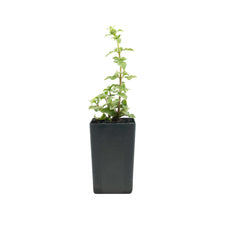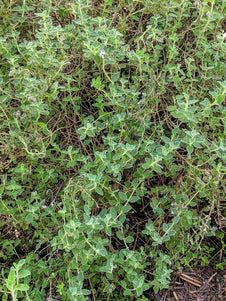







Oregano Zaatar
Oregano Zaatar

- In stock, ready to ship
- Inventory on the way

Usually available: April to November
Life cycle: Perennial
Height: 40cm
Position: Full sun
Soil preference: Well drained
This is how we pack and send your Herb Plants to all states except TAS & WA
You will receive
- 1 Oregano Zaatar Herb Plant in a 50 X 75mm tube - General growing instructions
All of our Herb Plants are grown organically with certified organic potting mixes and fertilizers
Botanical Name: Origanum syriaca
Oregano Za’atar is a small, woody perennial growing to about 40cm and with the ability to spread widely from 1-2 meters. It has a semi upright growth habit, with soft downy green-grey leaves. They are deeply veined and are distinctly heart shaped with the wide end towards the base. It has white flower heads shaped like cones. This herb grows naturally throughout the Levant region, including Lebanon, Syria, Palestine, Jordan and surrounding areas.
Za’atar is the Arabic name for Oreganum syriacum and the plant has a long history, including recorded use in Ancient Egypt. It may go by many other names including Wild Za’atar, Wild Middle Eastern Oregano, Wild Thyme, Lebanese Oregano, Majoram syriaca, and Ezov. Bible Hyssop is another name used but this is a name used for many plants in this region.
Confusingly, Za’atar is also a name used for more than one type of herb plant in the Middle East. It is also a name given to blends that contain a majority of za’atar or Origanum syriacum. Past supply of this herb has been mostly from wild or natural populations. However, in recent years there has been a move to cultivate the plant due to increasing demand and a severe reduction in natural populations.
There are many different varieties of oregano, each with different characteristics and culinary uses. Oregano also has powerful healing properties including use as a painkiller, anti-septic and anti-inflammatory.
Please see our description of Common Oregano and our other Oregano Varieties for more information.
Growing Conditions
Oregano za’atar prefers full sun conditions but can tolerate a little shade. It requires a well drained soil, but can tolerate a range of soil conditions due to the tendency towards poorer soils in its native Mediterranean habitat. Dryness is tolerated and water requirements are average to low, but extra moisture in hot summers is appreciated. Za’atar is considered a fast to medium grower and is very hardy. It also does well in a container and trails over the edge nicely.
Medicinal Uses
Oregano za’atar contains carvacrol a terpenoid similar to thymol that acts to inhibit certain kinds of bacteria, by eroding the cells walls of the bacteria. In older times, such as during the Lebanese civil war, za’atar was consumed to make the mind more alert and the body strong. However, this may have been a product of limited food availability as much as actual belief.
Culinary Uses
Oregano za’atar is said to be one of the tastiest oregano like herbs and it is a keystone herb in the Middle East. Za’atar is also a name used for several spice and herb blends, as well as just the herb itself. Its use may depend on which mix you intend to use and it is best to check contents as many herbs go by the name za’atar in the Middle East. The herb is used extensively in Middle Eastern countries and is becoming popular in other countries due to its bold, spicy flavour and strong aroma. Common uses include flavouring hommus, dips and soups. However, za’atar may be used in salads, with olive oil, garlic and other herbs on sough dough or flat bread, with eggs or on simple pizzas. The herb may be used fresh or dried and is often mixed with sesame seed, sumac seed and salt to create a blend. To harvest this herb fresh, collect the stems when they are 6-10cm tall.
All information provided on this website is for informational purposes only. Please seek professional advice before commencing any treatment.





